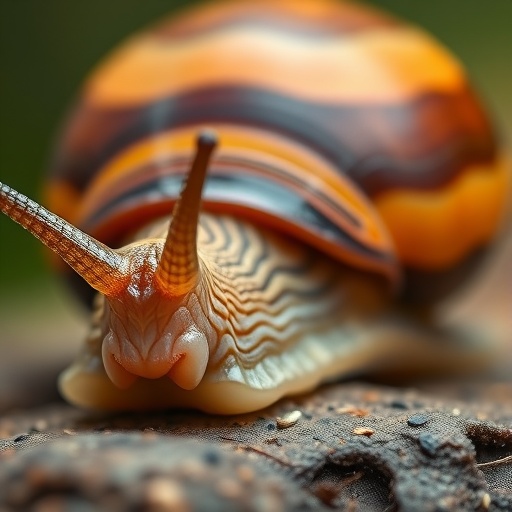In a remarkable leap forward in regenerative biology, scientists at the Stowers Institute for Medical Research have unveiled groundbreaking findings centered on the apple snail, Pomacea canaliculata. This humble mollusk boasts eyes that are astonishingly similar in structure to human eyes, complete with a lens, cornea, and retina. What sets these creatures apart is their extraordinary capacity to regenerate their eyes entirely after injury or even amputation—an ability that vertebrate eyes, including those of humans, simply lack. This novel research paves the way for profound insights into sensory organ regeneration that may eventually transform treatments for human eye diseases such as macular degeneration.
The investigative team, led by former postdoctoral researcher Dr. Alice Accorsi and Stowers President Dr. Alejandro Sánchez Alvarado, has proposed the apple snail as a genetically tractable non-vertebrate model organism for eye regeneration research. Published in Nature Communications in August 2025, their work establishes a comprehensive system for studying the molecular and cellular mechanisms underlying complete camera-type eye regeneration. Crucially, the researchers developed advanced gene-editing tools, adapting CRISPR-Cas9 technology to apple snails to manipulate specific genes involved in eye development and regeneration.
Eye regeneration in the apple snail unfolds in a precisely orchestrated sequence spanning approximately 28 days and four key phases. Initially, rapid wound healing occurs, mirroring the limited regenerative response in vertebrates. Subsequently, a specialized cell mass, likely comprising progenitor or stem-like cells, forms at the site of injury, laying the foundation for new eye structures. Following this, remarkable differentiation leads to the emergence of both the lens and retina, critical components of the camera-type eye. The final stage, maturation, involves the complete functional assembly of all ocular tissues to restore visual capability.
At the core of this regenerative prowess lies the gene pax6, a master regulator universally known for its role in eye development across diverse species—from vertebrates to fruit flies. The team demonstrated for the first time that pax6 is not only present in apple snails but is absolutely essential for the formation of their eyes. Using CRISPR-Cas9 to disrupt pax6 function, they engineered gene-edited snails that developed without eyes, yet remained viable and healthy. This striking phenotype solidifies the apple snail as a powerful system for dissecting gene function related to eye development and regeneration.
This work heralds a paradigm shift because it combines two rare attributes in one model organism: the ability to fully regenerate a complex sensory organ and the capacity for precise genetic manipulation. The synergy of these features makes the apple snail a uniquely valuable platform for mechanistic studies that could illuminate how genetic networks are reactivated after injury to drive tissue regeneration. Understanding these pathways may identify therapeutic targets for treating devastating human eye conditions that currently have limited remedies.
During the investigation, transcriptomic analyses were conducted at every stage of the eye regeneration process. By profiling gene expression dynamics over time, the team compiled a curated list of candidate genes potentially critical for driving regeneration and developmental reprogramming. Future studies using targeted gene disruptions will validate the functions of these candidates, further decoding the genetic blueprint that orchestrates sensory organ restoration from the wound site to a fully functional eye.
The importance of this research resonates throughout the broader scientific community, especially among experts studying mollusk biology. As noted by Dr. Angus Davison of the University of Nottingham, this endeavor fills a significant gap by providing a genetically tractable mollusk model, thereby enabling detailed genomic and developmental analyses that were previously unattainable in this diverse animal group. Such advances not only refine our understanding of molluscan evolution but also have cross-phylum implications for regenerative biology and genetics.
From a translational perspective, this study opens new avenues for ophthalmological innovation. The apple snail’s regenerative mechanism serves as a natural template, offering clues about cellular plasticity, stem cell activation, and tissue remodeling that mammalian eyes lack. By unraveling these biological processes in a controlled experimental setting, researchers can aspire to harness or mimic similar pathways in human tissues, potentially revolutionizing how retinal degeneration, trauma-induced blindness, and other ocular disorders are managed.
Furthermore, the successful application of CRISPR-Cas9 gene editing in apple snails exemplifies a growing trend in expanding genetic toolkits to non-traditional model organisms. Overcoming technical barriers to manipulate the genome in such species not only broadens the horizon of biological research but also enhances its ecological and evolutionary relevance. The ability to induce stable gene knockouts in the apple snail accelerates functional genomics studies, teasing apart the intricate gene networks essential for regeneration.
The research team’s perseverance, innovation, and multidisciplinary approach have culminated in a robust experimental framework, allowing the scientific community to plunge deeper into the fundamental principles guiding organ regeneration. Importantly, their work underscores that with focused effort and creative methodology, organisms once considered challenging for genetic study can become accessible and illuminate fundamental biological phenomena once thought beyond reach.
In summary, the establishment of the apple snail as a genetically manipulable system for complete eye regeneration represents a monumental stride in developmental biology and regenerative medicine. This model offers an unprecedented window into the genetic and cellular orchestration of complex organ regeneration, holding immense promise for understanding the limitations of human eye repair and guiding future therapeutic strategies. As this field matures, the apple snail may well become emblematic of nature’s intrinsic regenerative potential, inspiring scientists and clinicians alike to rethink the possibilities of healing in sensory organs and beyond.
Subject of Research: Animals
Article Title: A genetically tractable non-vertebrate system to study complete camera-type eye regeneration
News Publication Date: 6-Aug-2025
Web References:
- Stowers Institute for Medical Research: www.stowers.org
- Study DOI: 10.1038/s41467-025-61681-6
References:
- Accorsi, A., Sánchez Alvarado, A., et al. (2025). A genetically tractable non-vertebrate system to study complete camera-type eye regeneration. Nature Communications. DOI: 10.1038/s41467-025-61681-6
Image Credits: Stowers Institute for Medical Research
Keywords: Regeneration, Developmental biology, Genetic engineering, CRISPR-Cas9, Eye regeneration, Pomacea canaliculata, pax6 gene, Sensory organ regeneration, Molecular biology, Stem cell differentiation, Evolutionary biology, Molecular genetics




